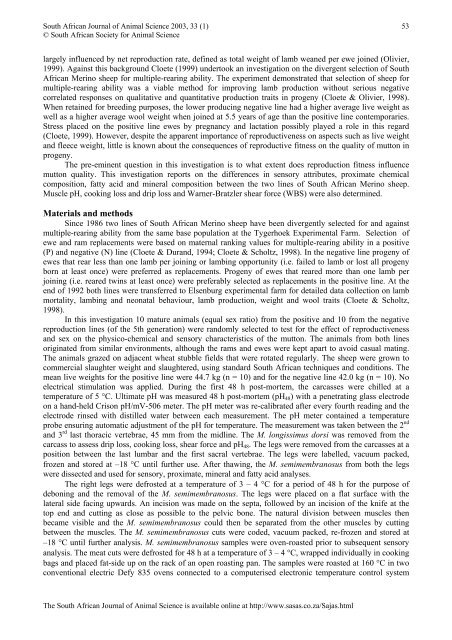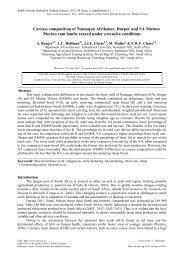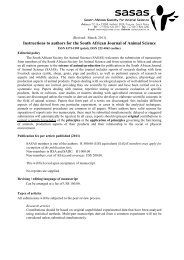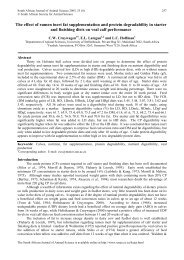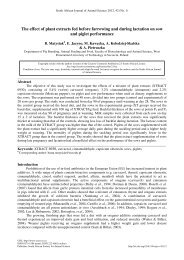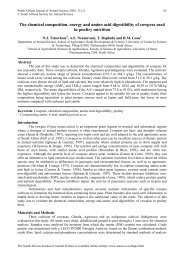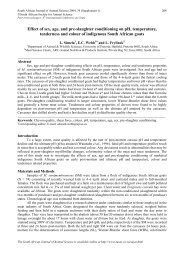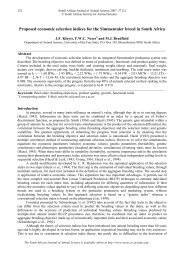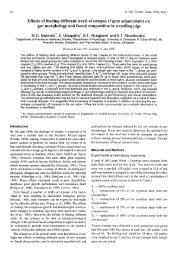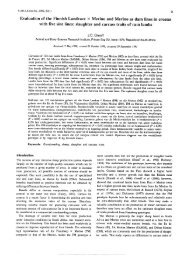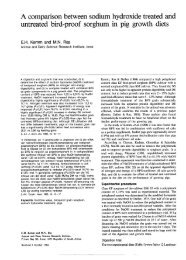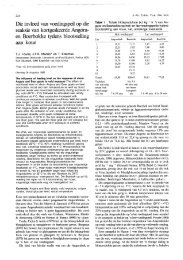Sensory and objective mutton quality characteristics of SA - African ...
Sensory and objective mutton quality characteristics of SA - African ...
Sensory and objective mutton quality characteristics of SA - African ...
You also want an ePaper? Increase the reach of your titles
YUMPU automatically turns print PDFs into web optimized ePapers that Google loves.
South <strong>African</strong> Journal <strong>of</strong> Animal Science 2003, 33 (1)<br />
© South <strong>African</strong> Society for Animal Science<br />
53<br />
largely influenced by net reproduction rate, defined as total weight <strong>of</strong> lamb weaned per ewe joined (Olivier,<br />
1999). Against this background Cloete (1999) undertook an investigation on the divergent selection <strong>of</strong> South<br />
<strong>African</strong> Merino sheep for multiple-rearing ability. The experiment demonstrated that selection <strong>of</strong> sheep for<br />
multiple-rearing ability was a viable method for improving lamb production without serious negative<br />
correlated responses on qualitative <strong>and</strong> quantitative production traits in progeny (Cloete & Olivier, 1998).<br />
When retained for breeding purposes, the lower producing negative line had a higher average live weight as<br />
well as a higher average wool weight when joined at 5.5 years <strong>of</strong> age than the positive line contemporaries.<br />
Stress placed on the positive line ewes by pregnancy <strong>and</strong> lactation possibly played a role in this regard<br />
(Cloete, 1999). However, despite the apparent importance <strong>of</strong> reproductiveness on aspects such as live weight<br />
<strong>and</strong> fleece weight, little is known about the consequences <strong>of</strong> reproductive fitness on the <strong>quality</strong> <strong>of</strong> <strong>mutton</strong> in<br />
progeny.<br />
The pre-eminent question in this investigation is to what extent does reproduction fitness influence<br />
<strong>mutton</strong> <strong>quality</strong>. This investigation reports on the differences in sensory attributes, proximate chemical<br />
composition, fatty acid <strong>and</strong> mineral composition between the two lines <strong>of</strong> South <strong>African</strong> Merino sheep.<br />
Muscle pH, cooking loss <strong>and</strong> drip loss <strong>and</strong> Warner-Bratzler shear force (WBS) were also determined.<br />
Materials <strong>and</strong> methods<br />
Since 1986 two lines <strong>of</strong> South <strong>African</strong> Merino sheep have been divergently selected for <strong>and</strong> against<br />
multiple-rearing ability from the same base population at the Tygerhoek Experimental Farm. Selection <strong>of</strong><br />
ewe <strong>and</strong> ram replacements were based on maternal ranking values for multiple-rearing ability in a positive<br />
(P) <strong>and</strong> negative (N) line (Cloete & Dur<strong>and</strong>, 1994; Cloete & Scholtz, 1998). In the negative line progeny <strong>of</strong><br />
ewes that rear less than one lamb per joining or lambing opportunity (i.e. failed to lamb or lost all progeny<br />
born at least once) were preferred as replacements. Progeny <strong>of</strong> ewes that reared more than one lamb per<br />
joining (i.e. reared twins at least once) were preferably selected as replacements in the positive line. At the<br />
end <strong>of</strong> 1992 both lines were transferred to Elsenburg experimental farm for detailed data collection on lamb<br />
mortality, lambing <strong>and</strong> neonatal behaviour, lamb production, weight <strong>and</strong> wool traits (Cloete & Scholtz,<br />
1998).<br />
In this investigation 10 mature animals (equal sex ratio) from the positive <strong>and</strong> 10 from the negative<br />
reproduction lines (<strong>of</strong> the 5th generation) were r<strong>and</strong>omly selected to test for the effect <strong>of</strong> reproductiveness<br />
<strong>and</strong> sex on the physico-chemical <strong>and</strong> sensory <strong>characteristics</strong> <strong>of</strong> the <strong>mutton</strong>. The animals from both lines<br />
originated from similar environments, although the rams <strong>and</strong> ewes were kept apart to avoid casual mating.<br />
The animals grazed on adjacent wheat stubble fields that were rotated regularly. The sheep were grown to<br />
commercial slaughter weight <strong>and</strong> slaughtered, using st<strong>and</strong>ard South <strong>African</strong> techniques <strong>and</strong> conditions. The<br />
mean live weights for the positive line were 44.7 kg (n = 10) <strong>and</strong> for the negative line 42.0 kg (n = 10). No<br />
electrical stimulation was applied. During the first 48 h post-mortem, the carcasses were chilled at a<br />
temperature <strong>of</strong> 5 °C. Ultimate pH was measured 48 h post-mortem (pH 48 ) with a penetrating glass electrode<br />
on a h<strong>and</strong>-held Crison pH/mV-506 meter. The pH meter was re-calibrated after every fourth reading <strong>and</strong> the<br />
electrode rinsed with distilled water between each measurement. The pH meter contained a temperature<br />
probe ensuring automatic adjustment <strong>of</strong> the pH for temperature. The measurement was taken between the 2 nd<br />
<strong>and</strong> 3 rd last thoracic vertebrae, 45 mm from the midline. The M. longissimus dorsi was removed from the<br />
carcass to assess drip loss, cooking loss, shear force <strong>and</strong> pH 48 . The legs were removed from the carcasses at a<br />
position between the last lumbar <strong>and</strong> the first sacral vertebrae. The legs were labelled, vacuum packed,<br />
frozen <strong>and</strong> stored at –18 °C until further use. After thawing, the M. semimembranosus from both the legs<br />
were dissected <strong>and</strong> used for sensory, proximate, mineral <strong>and</strong> fatty acid analyses.<br />
The right legs were defrosted at a temperature <strong>of</strong> 3 – 4 °C for a period <strong>of</strong> 48 h for the purpose <strong>of</strong><br />
deboning <strong>and</strong> the removal <strong>of</strong> the M. semimembranosus. The legs were placed on a flat surface with the<br />
lateral side facing upwards. An incision was made on the septa, followed by an incision <strong>of</strong> the knife at the<br />
top end <strong>and</strong> cutting as close as possible to the pelvic bone. The natural division between muscles then<br />
became visible <strong>and</strong> the M. semimembranosus could then be separated from the other muscles by cutting<br />
between the muscles. The M. semimembranosus cuts were coded, vacuum packed, re-frozen <strong>and</strong> stored at<br />
–18 °C until further analysis. M. semimembranosus samples were oven-roasted prior to subsequent sensory<br />
analysis. The meat cuts were defrosted for 48 h at a temperature <strong>of</strong> 3 – 4 °C, wrapped individually in cooking<br />
bags <strong>and</strong> placed fat-side up on the rack <strong>of</strong> an open roasting pan. The samples were roasted at 160 °C in two<br />
conventional electric Defy 835 ovens connected to a computerised electronic temperature control system<br />
The South <strong>African</strong> Journal <strong>of</strong> Animal Science is available online at http://www.sasas.co.za/Sajas.html


